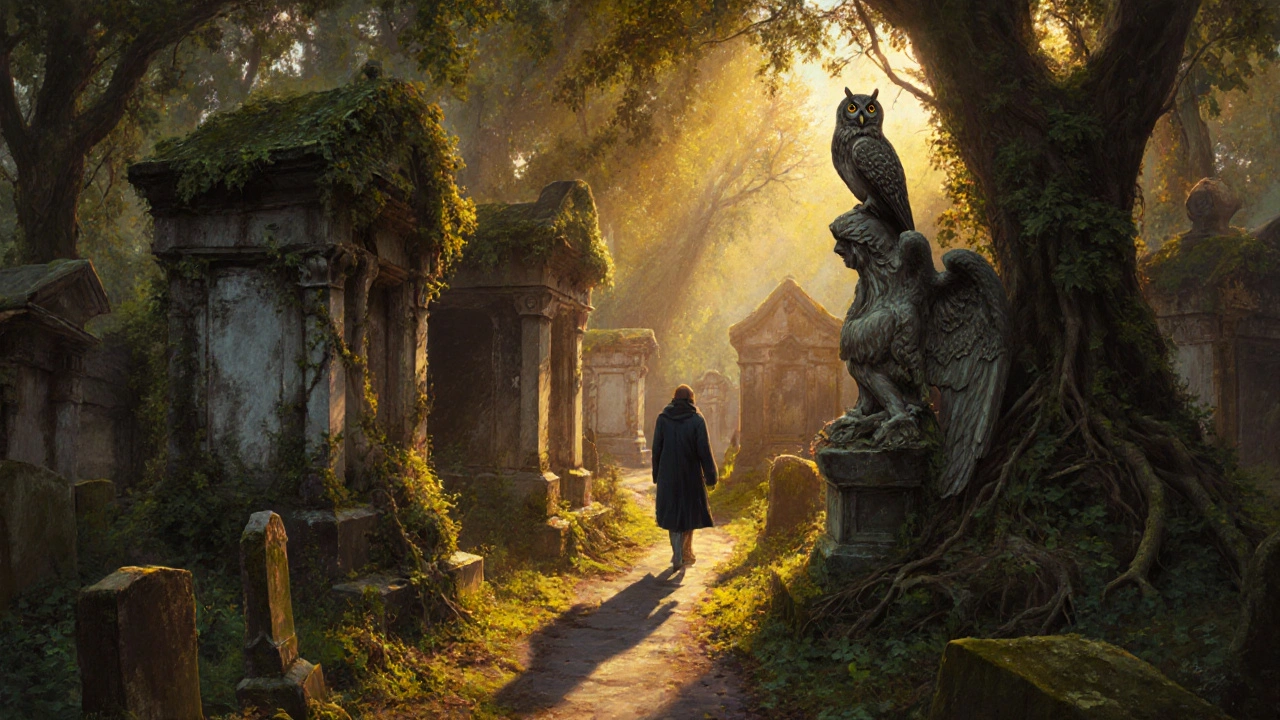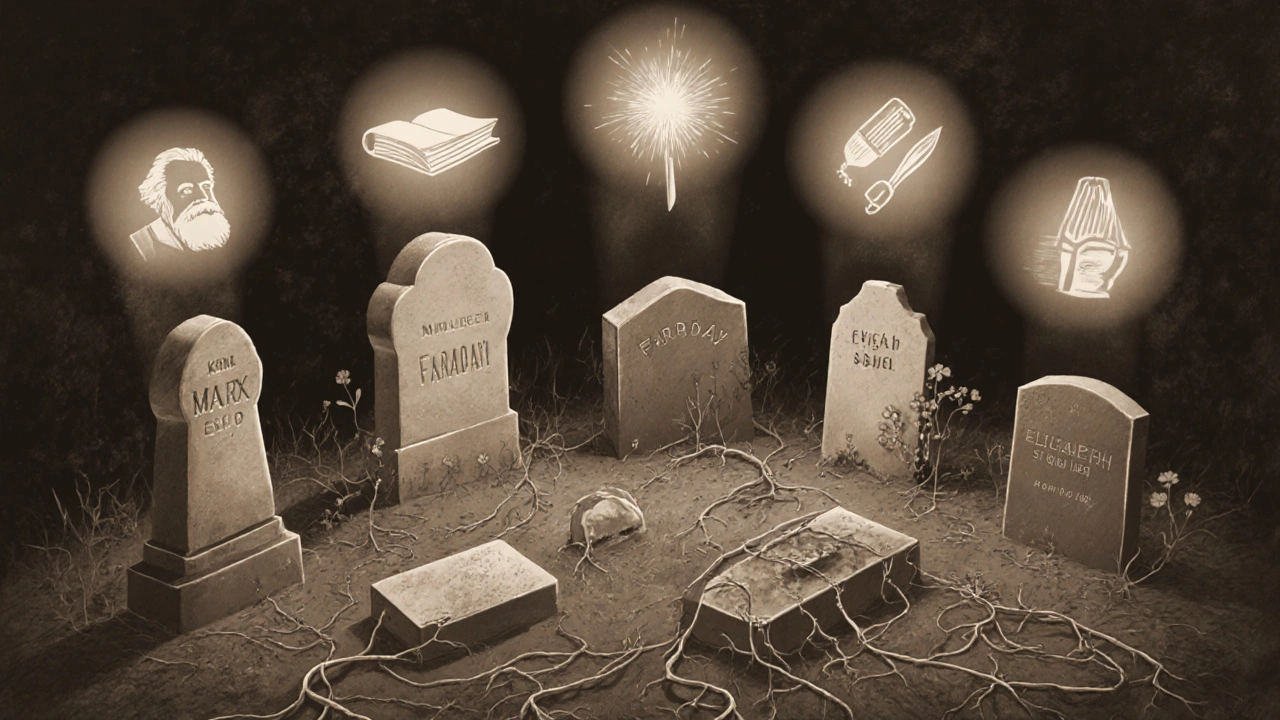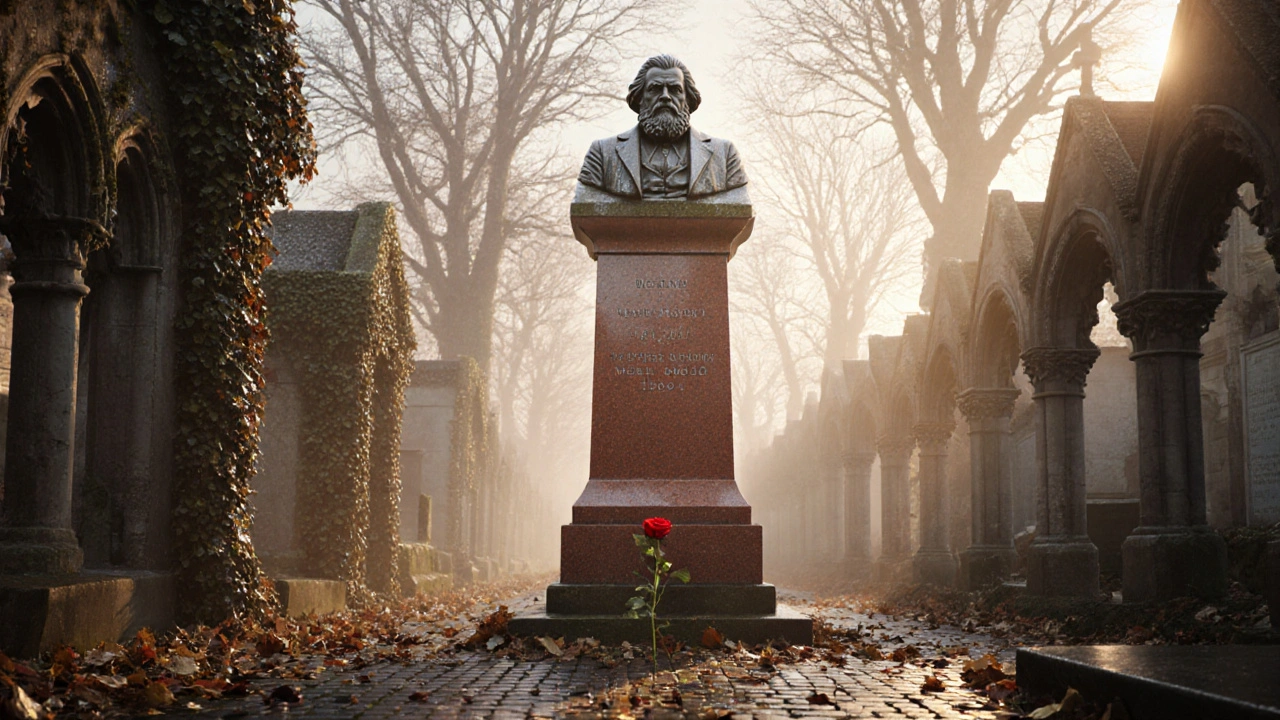Walking through Highgate Cemetery on a misty morning, you don’t just see headstones-you hear history. The rustle of leaves over 170,000 graves, the Gothic arches choked with ivy, the quiet hum of a city that never stops moving just beyond the walls. This isn’t just a burial ground. It’s a museum without walls, a time capsule of Victorian England, and the final address of some of the most influential people in modern history.
Why Highgate Cemetery Matters
Opened in 1839, Highgate Cemetery was one of the first private cemeteries built outside London’s city limits. At the time, churchyards were overflowing, cholera was killing thousands, and the city needed a new way to handle the dead. The London Cemetery Company designed Highgate as a garden cemetery-part park, part monument, part spiritual retreat. It was meant to be beautiful, peaceful, and inspiring. And it still is.
Unlike the crowded, uniform graveyards of the past, Highgate had winding paths, ornate tombs, and trees planted for shade. Families paid for plots based on status. The rich got grand mausoleums. The working class got simple, shared graves. The design was intentional: death wasn’t hidden. It was celebrated, mourned, and remembered in stone and iron.
The Grave of Karl Marx
If you visit Highgate Cemetery today, you’ll find one spot that draws more visitors than any other: the tomb of Karl Marx. His grave isn’t hidden. It’s bold. A 13-foot-tall monument of red granite, topped with a 6-foot bronze bust of his face, eyes stern, brow furrowed, as if still reading Das Kapital.
The original grave, installed in 1883 after his death, was modest. But in 1954, the British Communist Party raised funds to replace it with the monument you see now. The inscription on the base comes from The Communist Manifesto: “Workers of all lands, unite!” Below that, another line from Marx’s Theses on Feuerbach: “The philosophers have only interpreted the world; the point is to change it.”
People leave coins, flowers, and even copies of Marx’s books at the base. Some kiss the bust. Others just stand there, silent, as if waiting for him to speak. It’s one of the most visited graves in the world-not because Marx was a celebrity, but because his ideas changed the course of nations.
Other Notable People Buried Here
Marx isn’t the only famous name here. Highgate holds a who’s who of 19th-century British thinkers, artists, and innovators.
- George Eliot-the pen name of Mary Ann Evans, one of the greatest novelists of the Victorian era. Her tomb is plain, almost forgotten, tucked near the eastern side. No bust. No grand arch. Just quiet dignity.
- Michael Faraday-the scientist who discovered electromagnetic induction, laying the groundwork for electric motors and generators. His grave is simple, but his legacy powers your phone right now.
- John Clare-the “peasant poet” who wrote about nature and mental illness long before it was fashionable. His grave was unmarked for over a century until locals raised money to honor him.
- Elizabeth Siddal-model, artist, and muse to Dante Gabriel Rossetti. She was the face of Pre-Raphaelite art, famously posed as Ophelia in John Everett Millais’ painting. Her grave bears a poem Rossetti wrote for her.
- William Muir-a Scottish missionary and scholar who translated the Quran into English. His tomb is one of the few with Arabic inscriptions in the cemetery.
These aren’t just names on plaques. They’re people who shaped literature, science, politics, and art. Their graves sit side by side-not in rank, but in quiet coexistence. A socialist philosopher next to a Christian missionary. A poet next to a physicist. It’s a reminder that ideas, even opposing ones, can share the same soil.

The Two Sides of Highgate
Highgate Cemetery isn’t one place-it’s two. The East Cemetery and the West Cemetery are separated by Swain’s Lane. They’re different in feel, history, and access.
The East Cemetery is the original 1839 section. It’s the one with the famous tombs, the crumbling obelisks, and the sunken vaults. This is where Marx, Eliot, and Faraday rest. It’s open to the public through guided tours only. You can’t wander alone. You need a ticket and a guide to walk the paths. The tours last about 90 minutes. Guides tell stories-not just facts, but the human drama behind each grave. Who was buried here? Who paid for it? Who was forgotten?
The West Cemetery opened in 1854. It’s wilder. More overgrown. More haunting. No guided tours here. You can walk freely, but only during daylight hours. The tombs are older, more weathered. Some are half-swallowed by roots. Ivy climbs into the faces of angels. This is where you’ll find the most atmospheric photos-the kind you see on postcards. It’s also where the cemetery’s natural beauty shines brightest. Foxes live here. Owls call at dusk. The air smells like damp earth and old stone.
Many visitors don’t realize the West Cemetery is still active. New burials still happen. Families still buy plots. The cemetery doesn’t just preserve history-it continues it.
What to Expect When You Visit
If you’re planning a visit, here’s what you need to know.
- Tours: Book online in advance. East Cemetery tours run daily, but they fill up fast, especially in spring and autumn. The cost is £14 for adults, £10 for seniors, and free for children under 12. Tours start every hour from 10 a.m. to 3 p.m.
- What to wear: Paths are uneven. Cobblestones, mud, and roots make walking tricky. Wear sturdy shoes. Bring a light rain jacket-London weather changes fast.
- What to bring: A camera. A notebook. A sense of curiosity. No food or drink is allowed inside the cemetery. No drones. No loud music.
- When to go: Early morning or late afternoon offers the best light and fewest people. Weekdays are quieter than weekends. Avoid holidays-crowds swell around Halloween and May Day.
- Access: The nearest tube station is Archway (Northern Line). It’s a 20-minute walk. Or take bus 210 or 263 to Highgate Village. The main entrance is on Swain’s Lane.
Don’t expect a theme park. Don’t expect clean paths or gift shops. Highgate isn’t polished. It’s real. And that’s why it sticks with you.

Why This Place Still Speaks to Us
Why do millions come here every year? Not for the architecture. Not even just for Marx.
We come because Highgate reminds us that death doesn’t erase meaning. It frames it. The man who wrote about class struggle lies under a monument built by people who believed in his words. The poet who felt forgotten now has a crowd reading his lines. The scientist who unlocked electricity rests quietly, while his work runs the lights in every home in London.
Highgate doesn’t just bury the dead. It holds their questions. Their anger. Their dreams. Their failures. And it asks you, standing there in the cold morning air, what you’ll leave behind.
It’s not morbid. It’s human.
Can you visit Karl Marx’s grave without a tour?
No. Karl Marx’s grave is in the East Cemetery, which requires a guided tour to enter. You cannot walk in on your own. Tours are the only way to access the most famous graves, including Marx, George Eliot, and Michael Faraday. The West Cemetery is open for free self-guided visits, but Marx’s tomb is not there.
Is Highgate Cemetery still active for burials?
Yes. While most plots were sold in the 19th century, the cemetery still accepts new burials in remaining family plots and in designated areas of the West Cemetery. There are no public plots left, but families with existing rights can still add loved ones. The cemetery is managed by the Friends of Highgate Cemetery Trust, which ensures it remains a living memorial, not just a relic.
Are there any other famous graves in London like Highgate?
Yes. Kensal Green Cemetery has the grave of Isambard Kingdom Brunel, the engineer behind the Great Western Railway. Brookwood Cemetery, near Woking, is the largest in the UK and holds many Victorian figures. Westminster Abbey has memorials to scientists and poets, but it’s not a burial ground for most. Highgate stands out because it’s a public cemetery with both grand monuments and forgotten graves-no royal privilege needed.
Is Highgate Cemetery haunted?
Many people say it is. Ghost tours are popular, especially around Halloween. Locals report cold spots, whispers in empty pathways, and figures seen out of the corner of the eye. But there’s no evidence of anything supernatural. The eerie feeling comes from the atmosphere-the silence, the age of the stones, the way the light falls through the trees. It’s the weight of history, not ghosts, that makes you pause.
Can you take photos inside Highgate Cemetery?
Yes, photography is allowed for personal use in both the East and West cemeteries. Tripods and drones are not permitted. Some families still visit graves, so be respectful. Don’t block paths or touch monuments. The cemetery is a place of mourning, not a photo studio.
What to Do Next
If Highgate moved you, consider going deeper. Read George Eliot’s Middlemarch. Watch the documentary Marx and the Working Class. Walk through the West Cemetery at sunset and sit by the oldest tomb you can find. Write down what you feel.
Or better yet-plan your next visit. Spring brings bluebells under the yew trees. Autumn turns the leaves gold over Marx’s bust. Winter gives you the cemetery to yourself. And summer? Summer lets you sit quietly, listening to the birds, knowing you’re standing where history didn’t just end-it became part of the earth.
